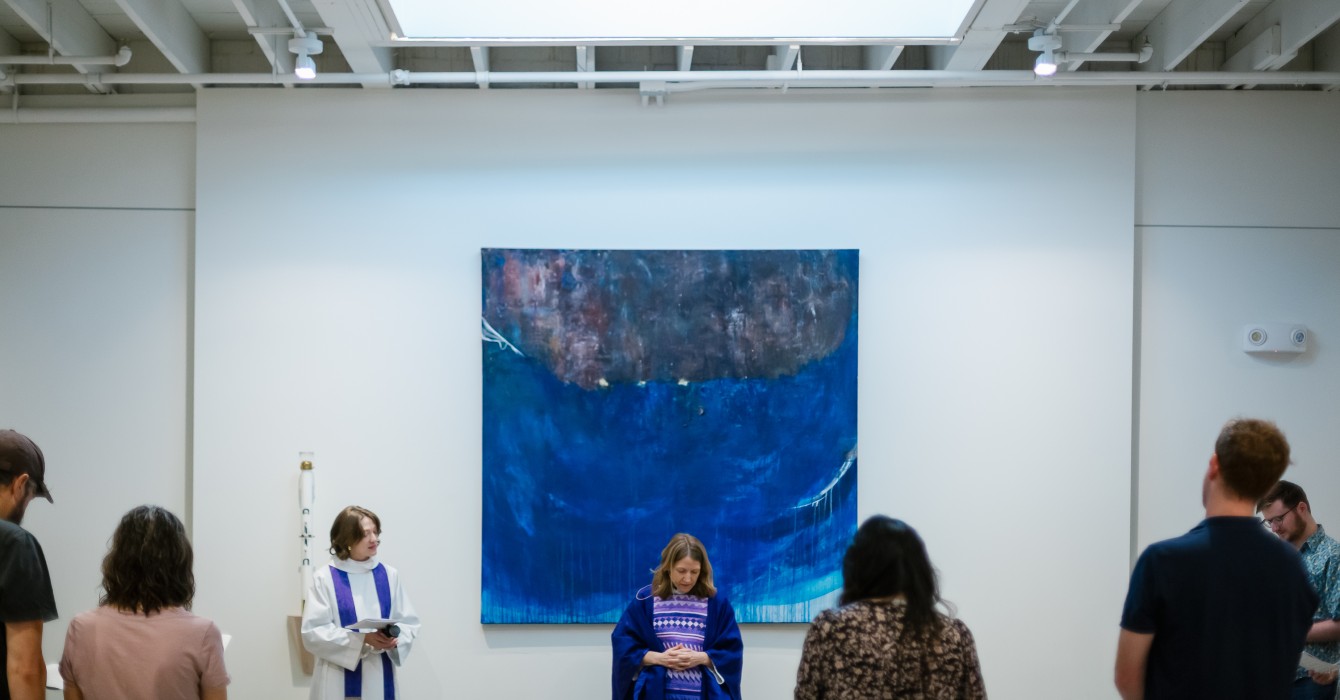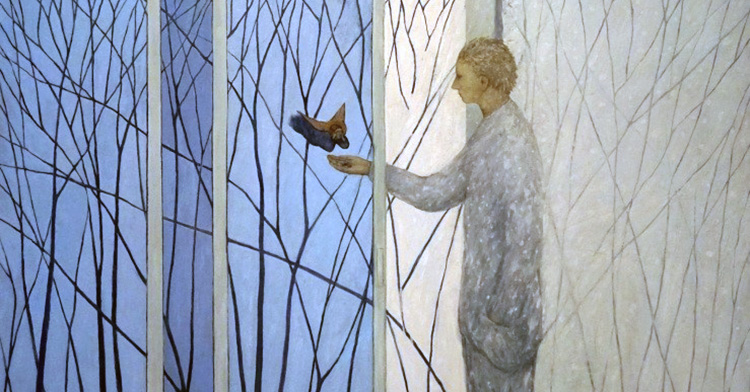 Robin Jensen is a patristic scholar who specializes in ancient Christian visual art. She is the Luce chancellor’s professor of the history of Christian art and worship at Vanderbilt Divinity School in Nashville, Tenn. Her scholarship, which includes such books as “Visual Theology: Forming and Transforming the Community through the Arts,” “Face to Face: Portraits of the Divine in Early Christianity” and “The Substance of Things Seen: Art, Faith, and the Christian Community,” insists -- against received views -- that ancient Christian art is theologically rich and multilayered.
Robin Jensen is a patristic scholar who specializes in ancient Christian visual art. She is the Luce chancellor’s professor of the history of Christian art and worship at Vanderbilt Divinity School in Nashville, Tenn. Her scholarship, which includes such books as “Visual Theology: Forming and Transforming the Community through the Arts,” “Face to Face: Portraits of the Divine in Early Christianity” and “The Substance of Things Seen: Art, Faith, and the Christian Community,” insists -- against received views -- that ancient Christian art is theologically rich and multilayered.
She talked to Faith & Leadership about one ancient image that particularly intrigues her, about the importance of teaching art and about traditioned innovation. The following is an edited transcript.
Q: Could you give us some examples of ancient Christian visual art that particularly move you and why?
There is a 6th-century apse from Sant’Apollinare in Classe, just outside of Ravenna, Italy, that has something to say about leadership in the church as an institution. It’s striking when you enter this church, because the image takes over the whole space. It’s absolutely beautiful: blue and green and gold and just glorious glass mosaic.
It depicts the transfiguration. In the background are colored clouds of red and yellow and pink in a cloudy, blue sky. Moses and Elijah are in the sky. The hand of God is coming down. Peter, James and John are here represented as three lambs looking up.
Christ is not represented visually. He is not a human figure. There’s an orb in a night sky with stars as a background, and inside this orb is a gemmed cross. And on the cross is a tiny portrait of Christ. You would miss it if you did not know it was there, because what you first see is the cross emblazoned on a night sky with a wreath around it, and that emblazoned on top of a sunrise sky with Moses and Elijah.
Below all of this is the saint, Apollinarius, who is the founding bishop of Ravenna and Paul’s companion. How he got to Ravenna I don’t know, but he did, according to the tradition, and founded the church there. He’s making the gesture of prayer. His arms are outstretched and he’s looking at both the congregation and this image of the transfiguration. And then there’s a beautiful paradisiacal scene of flowers, green grass, trees. The first thing lots of people notice are the flowers in this mosaic. It looks almost like a medieval tapestry.
If you lived in this town, you would have regularly seen the saint presented in the posture of prayer. He doesn’t look altogether different from the bishop of the church as he’s celebrating the Eucharist at the altar, directly below the saint. In fact, he’s wearing the pallium of a bishop.
Above all this is a triumphant but abstracted image of the transfiguration. The three disciples have become lambs, and Christ has become this cross, covered with gems. It’s a beautiful image of victory. The night sky is emblazoned over the sunrise sky, you get a sense that you’re looking through a window into space and past this earth in time and place. It’s really a layered image.
Perhaps one of the lessons of this is that you look from the altar, with a human leader or bishop there, to his prototype, the first bishop of Ravenna, who is also their sainted bishop. This is what the eucharistic moment does: it transfigures the body of Christ into this salvific cross of Christ and then takes us from sunrise into eternity.
Q: Have you heard the complaint that the comparison to a sheep is not complimentary to lay people?
You don’t want to not be in the flock. I don’t know when the sheep got such a bad rap, but certainly they are a very important symbol for the early church. In baptismal catechesis, bishops tell people about to be baptized they are becoming a member of the shepherd’s flock. The signing of the cross on the forehead of the just-baptized person is often compared to the branding of the sheep. Now the shepherd will know you. This is done with oil on the head of a real candidate, but it’s a permanent and indelible mark. You will always be able to be found should you get lost. That’s one of the beautiful images of the early church.
Q: You treat ancient Christian art with a great deal of reverence and kind of delight. Where does that come from?
I’m very visually tuned in. But I have also watched everybody that I’ve ever taken to this church in Ravenna walk into the space and stop and take a breath. It’s heartbreakingly beautiful. This image calls your attention. You can’t take your eyes off of it. And because it is so large and so central, a congregation turning toward the altar to watch the mystery of the Eucharist could not but be completely aware of the way the activity at the altar is in dialogical relationship to the image right above it.
Q: Your description of how you cannot look at this and not have your breath taken away sounds more like how Christians talk about God than how Christians usually talk about art.
When we think about coming to our encounter with God, we think about it visually. We’re promised a face-to-face vision at the end time. Everybody wants to see God’s face. Moses wants to see God’s face. Ezekiel sort of saw God’s face. Think of the book of Revelation. It’s all about what I see: the Lamb on the throne, the angels circling it, the rainbow. Isaiah looks and sees God. Well, I don’t know exactly what he saw, but it’s described there in Isaiah 6: high on the throne, the angels circling, the cherubim singing their song, “Holy, holy, holy.” That is a visual text.
Q: But other texts forbid human beings from seeing God. Or you can see God, but it might kill you. How do you reconcile those two different strands in the Scriptures?
Moses asks to see God, and God says, “I can’t show you myself. It’s too dangerous for you.” It doesn’t say God does not have an appearance, it just says the power of that appearance is beyond your ability to take in now. Later, at the transfiguration, Moses is there. The early church fathers point out that Moses now gets the vision, when Jesus is transfigured. Moses finally gets to see God’s face. It’s kind of wonderful.
There are all kinds of places and ways in which God appears in the Scriptures. In Genesis, Jacob sees God … and says, “Now I have seen God and lived.” Abraham sees God at the oaks of Mamre and it says he looked up and he saw the [three men]. In John 14, Philip asks Jesus if [the disciples] can see God. Jesus says, “You’re looking at him.” This is an affirmation of the visual. Art presents us with theophany in a way that we can take in. It’s not meant to be the illustration of what God looks like, but a provisional way that we have sight of God.
Q: How do you teach your students about the structured nature of Christianity?
Some of my students have a hard time with hierarchy, which they see as wrong and unjust. But without leadership, without structure, the church couldn’t have existed. There needs to be a way for a community to come together and agree on some things, and there has to be discipline (an even worse term for many of my students). How do we put aside our ego enough to be obedient to the demands of community life? How do we set aside our own interests and needs to be together?
Families have to figure this out. There has to be somebody who says, “We’re all going to get together at this time for this meal. It’s important that we’re all going to be here. It’s going to be at 6 p.m. Now, if you want to negotiate with me, I’m open to that. But we have to agree to do this together.” We can’t all go our separate ways and follow our own desires, because we would cease to be family.
The job of a leader is to create a place where people can work together toward a common goal that transcends the importance of the individual. A monastery, a church, a family all have to have this. Think of a theological institution: We have to agree on a curriculum. We can’t all decide what a master of divinity curriculum should be. Each of us would have a different curriculum if we could write one. If you asked 15 faculty each to write a curriculum, there would be 15 different curricula. How do we come together and decide which one we’re going to use?
Q: How does someone do that in a way that’s marked by Jesus?
A person willing to listen who can take the chance of making the decisions in the end: “All right, I’ve heard you all; I’m going to propose this.”
If you’ve ever watched a sheepdog herding sheep, it really works. I was fascinated by watching these dogs rounding up the sheep. Barking, barking, barking, running around and moving them forward. They’re obnoxious little things, and the sheep look like, “Excuse me? Who gave you this role?” That’s what the leader is: the person who rounds up the group.
I don’t think it’s at all about power. There is a charism, but it’s also about taking a chance at being the one who will push the group forward.
Q: Can we learn from some of the ways artists trained in the ancient world? Art doesn’t simply erupt out of nowhere.
The idea that art erupts out of nowhere is something very modern. In fact, we don’t have artists’ names until the Renaissance, when there arises a cult of the individual genius. The phenomenon of the individual genius is a recent development. Even in the Renaissance, great artists had workshops. Those paintings were not done just by one person. It was always an enterprise of the community. Sometimes this was a master with disciples. Masaccio and Titian didn’t do it all. It’s always an exercise in mentoring and training and learning.
And within that is a great role for obedience and discipline. How am I going to learn something unless I’m willing to turn over a certain amount of my own self-interest to following you for a while? I’ve got to be willing to submit.
The best learners are the people who are the least afraid to look stupid. If we’re terribly afraid of falling down or making mistakes, we’re never going to try at all. This is why adults don’t learn languages as well as children do. They have forgotten how to play. In playing you sometimes have to fail.
When we look back to our teachers and the people that influenced us, sometimes the ones that we most resisted, who really asked a lot of us, were the ones that gave us a lot. They were dictators. I regret that I don’t think I ask enough of my own students. They would get so much more from it in the end.
Q: You lament that in school we take away picture books too quickly. Tell us more about that.
Art classes at some point (perhaps fifth grade or so) are only for people who are going to be artists. We stop a little bit later with music. But what if we were to teach medical students to draw? Their powers of observation would be enhanced if they learned how to be visually observant, to notice the colors of things, to be conscious of light and dark shade, size or scale. Our educational system has truncated that ability.
You can show somebody that brown isn’t just brown, but many colors. A certain kind of light will make flesh turn a little different color of blue versus pink. That doesn’t make us all into painters or mosaicists or sculptors. It can make us all much better visual observers.
Q: How could drawing be a helpful component of training future ministers?
It might help the visual imagination. The Ignatian exercises are primarily an exercise in imaginative exegesis -- imagining the story in ways that are very sensual. You read a biblical story and you are asked in your meditation to think about what it really looked like. What did it smell like? How did it feel? Let’s be at the manger. What do the animals look like? Where are you in that picture? What are you going to say to the mother? Are you going to lift the baby up out of the manger? What will you say to the baby? What will you do with the baby? Will you kiss the baby? What’s the baby feel like? Individuals suddenly inhabit that world and recreate it differently each time they come back to it.
Q: Can you talk to us about traditioned innovation in terms of visual art?
I don’t know any artists who don’t spend a lot of time looking at other art and learning what artists have done throughout history. Innovation is based on attention to what has gone before -- either to push it in a different direction, to bring something else to it to bear upon it, or to strip it down to its essentials.
I was an art student for a number of years. Sometimes it’s just learning your chops, like pianists would have to do, learning scales in a Western system. My version of that was that I spent hours and hours of my life drawing. This was mainly training not my hand but my eye. The hand comes along with the eye, but the eye is what you’re really training. Once you have the eye trained, that allows you to do improvisation, to open up and question and break some rules.








